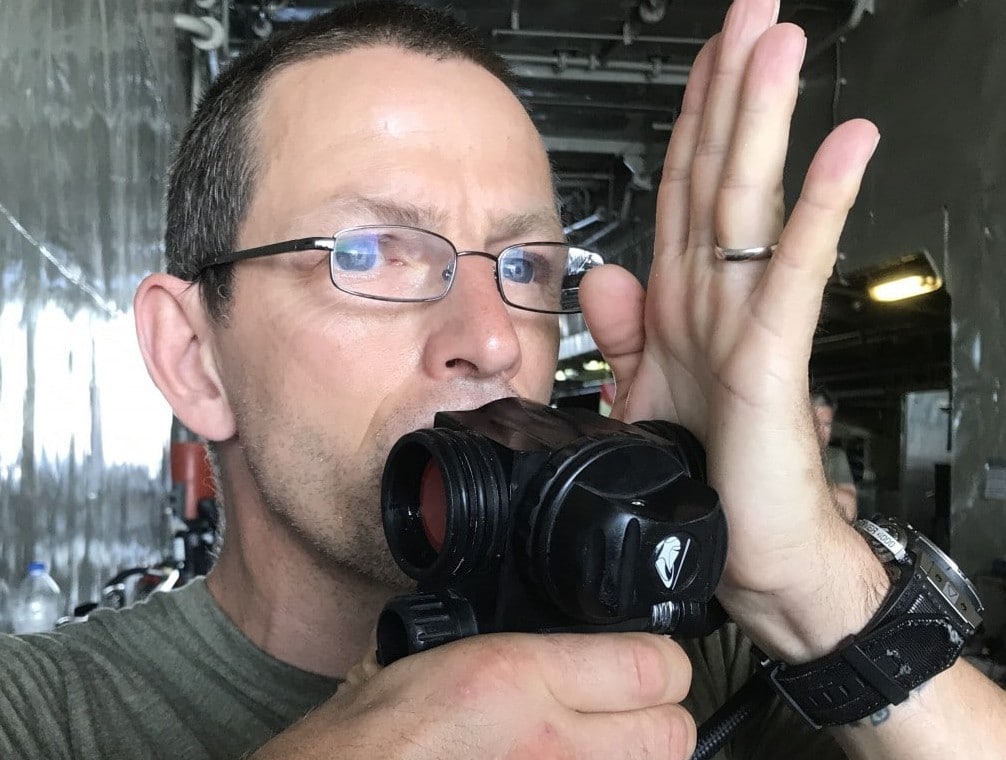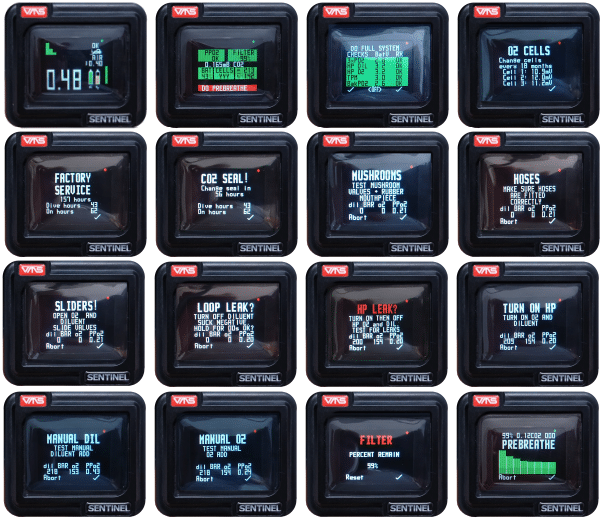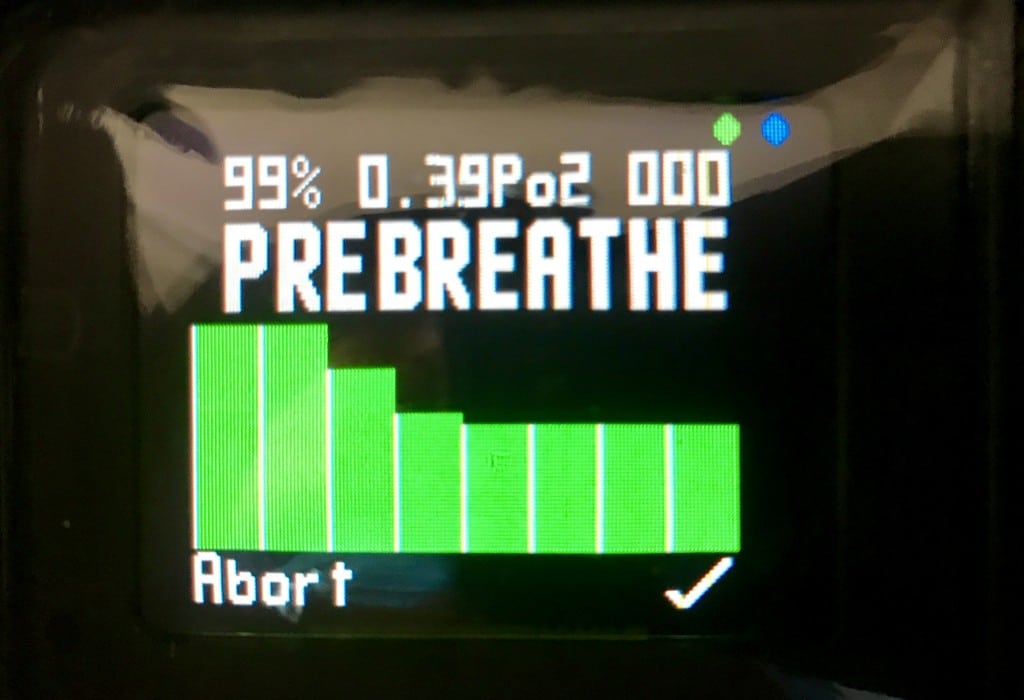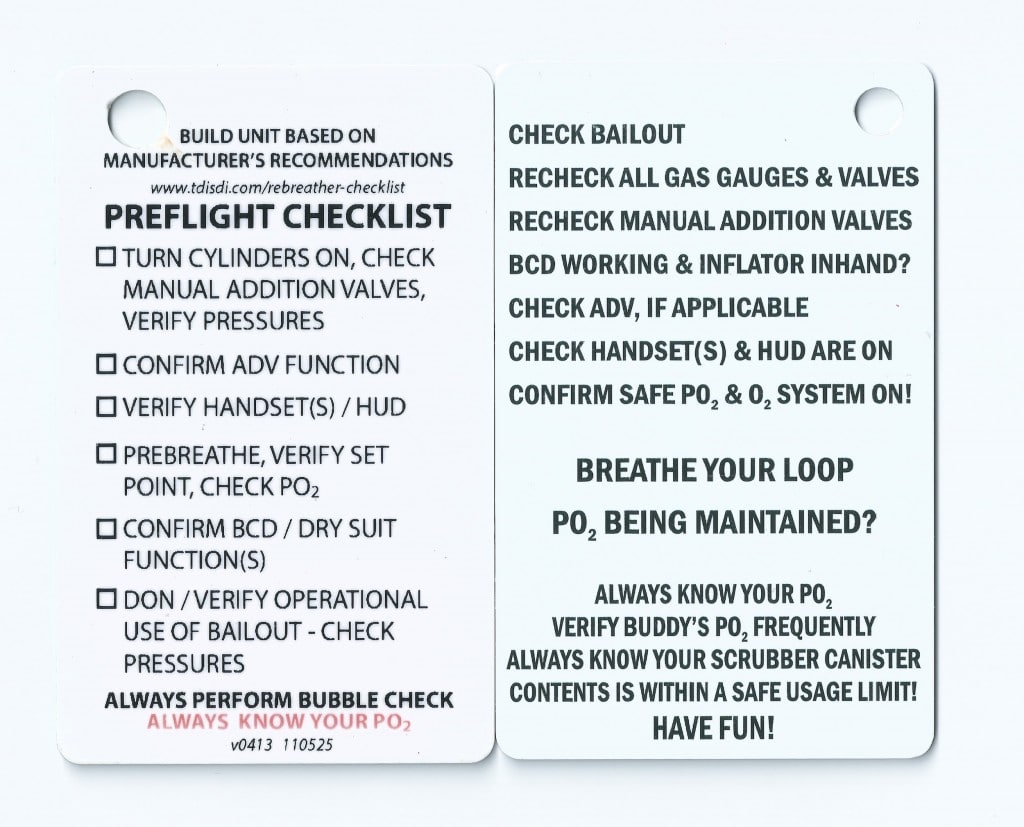News
Rebreather Pre-Dive Checks

The following is a discussion and review of the subject of Pre Dive checks when diving rebreathers – a much discussed, varied and often controversial matter!
When we first learn to dive, the concept of a buddy check, pre dive check or safety drill is installed in us as a means to make the dive safer by spotting potential problems before they can manifest and potentially evolve into accidents.
This is not a procedure limited to diving, it is extremely common in the Aviation, Aerospace and military communities, but to bring it closer to home it is present when we drive a car. When we drive a simple, mainly mechanical, car we are aware of the pre drive steps of checking the coolant level, the tyre pressures and the oil level and then adjusting the seat, wing and rear view mirrors to the individual driver. In a more modern, computer controlled car, many of these checks may be completed by the control system and communicated to the driver via dash board instrumentation and at the high end, even the seat and mirror settings can be altered to individual drivers with the push of a button. What is most common is a combination of automated computer generated checks and manual human checks; either way we are assured of the functionality of the vehicle before heading out on the road.
With rebreather technology the source of the pre dive check sequence and method could come from a variety of places. The manufacturer of the specific rebreather, a training agency that teach a specific rebreather, a generic training agency rebreather check list to suit all rebreathers and a learnt acronym to prompt the required checks.
Of course it would be best if available to use the specific rebreather check list or system supplied by the manufacturer.
Within the above there are different ways to complete checks:
- A written check list
- A check list acronym – e.g a common rebreather check list reminder is the acronym of F.L.A.G.S.
- Flow
- Loop
- Analyse
- Gauges
- Stack/Sensors
- Electronic check lists within the rebreathers display

- Electronic check lists that analyse data from the actual components of the rebreather.

What should be checked?
Pre-Assembly
Mushroom (One Way) Valves. The one way check valves within the Mouthpiece assembly that ensure the gas flows around the rebreather in a single correct direction should be tested to ensure they open with and close against FLOW.

The Oxygen, Diluent, Single supply gas and all bailout cylinders for the planned dive should be ANALYSED.
The absorbent canister (STACK) should be either re-packed or replaced. Or the used time of a previously used canister should be noted and the remaining time available compared to the dive plan.
Pre-Dive
There are as many pre dive check sequences as there are rebreathers, in fact many more! So for initial discussion of the steps of pre dive checks we will here use the acronym FLAGS as a starting point. Although not exhaustive if the printed check sheets or on screen check prompts of most of the currently available rebreathers are reviewed all steps within them can be classified under one of the following prompt words:
F – FLOW
Ambient pressure gas flow around the rebreather in a single correct direction. Tested with the Mushroom (One Way) valve check as part of Pre Assembly. This should be tested prior to each dive as stray granules of absorbent etc could compromise a Mushroom Valve.
High pressure and intermediate pressure gas flow around the rebreather. Slowly turn on the cylinder valves and then add Diluent and Oxygen manually, inflate and check dumps on BCD/wing, check that the ADV and BOV function and ensure the solenoid can inject oxygen where applicable to each specific type of rebreather.
L – LOOP
Conduct a negative loop test and a positive loop test where appropriate to each style of rebreather.
A negative test is conducted on a completely assembled rebreather by placing the mouthpiece in the rebreather or closed circuit position and breathing in through the mouth (To empty the loop) and out through the nose until the loop is empty and then closing the mouthpiece. A suitable period of time (A minimum of 1 minute) is allowed to pass and the rebreather should maintain that negative i.e. not leak air into to rebreather.
Indications of a good negative can include, crushed breathing hoses, ADV diaphragm remaining concave or in, a lower PO2 than ambient (e.g. Pre negative mouthpiece open PO2 0.21, during negative mouthpiece closed 0.19) and a strong ‘gasp’ or sucking sound when opening the mouthpiece at the end of the check.
A positive test is conducted on a completely assembled rebreather by placing the mouthpiece in the rebreather or closed circuit position and breathing in through the nose and out through the mouth until the loop is full and then closing the mouthpiece. A suitable period of time (A minimum of 1 minute) is allowed to pass and the rebreather should maintain that positive i.e. not leak air out of rebreather.
Indications of a good positive can include rigid inflated counter lungs.
A – ANALYSE
The Rebreather although containing Oxygen sensors must not be used to analyse the gases used within the rebreather.
All gases, Oxygen, Diluent and all bailouts should be analysed and labeled prior to being assembled into the rebreather or as bailouts with an Oxygen or where required an Oxygen/Helium analyser.
Many rebreathers are calibrated by flushing them completely or flushing a sensing chamber where the sensors sit with Oxygen at Ambient pressure, if this were completed with a gas supply other than specified (i.e. Oxygen) then the calibration would be inaccurate and therefore the PO2 incorrect during the dive.
G – GAUGES
Test the contents of all required cylinders, Oxygen, Diluent and all required bailout and check for leaks.
Turn on (Slowly) cylinder valves and note the reading of pressure.
Turn off cylinder valves and leave off for 1 minute.
Check contents pressure has not dropped (If the pressure has dropped there is an HP or IP leak to be located and resolved)
S – STACK / SENSORS
The rebreather should be tested for basic function by the Pre Breathe detailed below.
The purpose of this check is to watch the 3 sensor outputs for stabilisation, correct reading and change on prompt i.e. whist breathing add Oxygen and note a rise in PO2 and then add Diluent and note a drop in PO2 from set point.
If fitted during the Pre Breathe a Carbon Dioxide sensor can be monitored for a rising figure.
Again if fitted on the specific rebreather a thermal activity monitor ‘Temp Stick’ can be monitored to ascertain the exothermic reaction of the sofnolime absorbing Carbon Dioxide causing thermal sensors within the stack to register a rise in temperature.
Pre-Breathe
The fully assembled Pre Dive checked rebreather should be breathed for an adequate time to assure the user of systems functionality.
This is the period when the above Stack/Sensors tests are performed.
Current research would indicate that a part used, over used, poorly packed, incorrectly fitted or even absent stack may not give enough signs or symptoms of Hypercapnia during a 3-5 minute Pre Breathe to ensure a diver notices and considers the rebreather unfit for use.
Quick Pre Jump Confirmation
Many training agencies provide Pre Jump quick check prompt cards that can be attached to the Rebreather.

Steps on these include but are not limited to:
- Cylinder valves fully open on Oxygen, Diluent, Single supply gas and bailout?
- Electronics on and safe breathable PO2 displayed?
- BCD inflated?
- Mouthpiece in mouth and in rebreather position?
These Pre Jump checks are NOT considered a full Pre Dive check and are in no way meant to replace full Pre assembly, Pre Dive and Pre Dive checks. The Pre Jump is intended to be used in addition to normal checks as a last check just prior to water entry.
Find out more about Phil at www.philshorttechnical.co.uk.
Gear News
Scubapro Free Octopus Promotion 2024

Free Octopus with every purchase of a SCUBAPRO regulator system
Just in time for the spring season, divers can save money with the FREE OCTOPUS SPRING PROMOTION! Until July 31st SCUBAPRO offers an Octopus for free
with every purchase of a regulator system!
Get a free S270 OCTOPUS with purchase of these combinations:
MK25 EVO or MK19 EVO with A700
MK25 EVO or MK19 EVO with S620Ti
MK25 EVO or MK19 EVO with D420
MK25 EVO Din mit S620Ti-X
Get a free R105 OCTOPUS with purchase of the following combinations:
MK25 EVO or MK19 EVO with G260
MK25 EVO or MK17 EVO with S600
SCUBAPRO offers a 30-year first owner warranty on all regulators, with a revision period of two years or 100 dives. All SCUBAPRO regulators are of course certified according to the new European test standard EN250-2014.
Available at participating SCUBAPRO dealers. Promotion may not be available in all regions. Find an authorized SCUBAPRO Dealer at scubapro.com.
More information available on www.scubapro.com.
Blogs
Northern Red Sea Reefs and Wrecks Trip Report, Part 3: The Mighty Thistlegorm

Jake Davies boards Ghazala Explorer for an unforgettable Red Sea diving experience…
Overnight, the wind picked up, making the planned morning dive a bit bumpy on the Zodiacs to the drop point on Thomas Reef. There, we would dive along the reef before descending through the canyon and then passing under the arch before ascending the wall with a gentle drift. The site provided great encounters with more pelagic species, including shoals of large barracuda, tuna, and bigeye trevally.
Once back on the boat, it was time to get everything tied down again as we would head back south. This time, with the wind behind us, heading to Ras Mohammed to dive Jackfish Alley for another great gentle drift wall dive before then heading up the coast towards the Gulf of Suez to moor up at the wreck of the Thistlegorm. This being the highlight wreck dive of the trip and for many onboard, including myself, it was the first time diving this iconic wreck. I had heard so much about the wreck from friends, and globally, this is a must on any diver’s list. Fortunately for us, there was only one other boat at the site, which was a rarity. A great briefing was delivered by Ahmed, who provided a detailed background about the wreck’s history along with all the required safety information as the currents and visibility at the site can be variable.

Kitting up, there was a lot of excitement on deck before entering the water and heading down the shoreline. Descending to the wreck, there was a light northerly current which reduced the visibility, making it feel more like the conditions that can be found off the Welsh coast. At 10m from the bottom, the outline of the wreck appeared as we reached the area of the wreck which had been bombed, as our mooring line was attached to part of the propeller shaft. Arriving on deck, instantly everywhere you looked there were many of the supplies which the ship was carrying, including Bren Carrier tanks and projectiles that instantly stood out.

We headed around the exterior, taking a look at the large propeller and guns mounted on deck before entering the wreck on the port side to take a look in the holds. It was incredible to see all the trucks, Norton 16H, and BSA motorcycles still perfectly stacked within, providing a real snapshot in time.

Overall, we had four dives on the Thistlegorm, where for all of the dives we were the only group in the water, and at times, there were just three of us on the whole wreck, which made it even more special, especially knowing that most days the wreck has hundreds of divers. Along with the history of the wreck, there was plenty of marine life on the wreck and around, from big green turtles to batfish, along with shoals of mackerel being hunted by trevally. Some unforgettable dives.

The final leg of the trip saw us cross back over the Suez Canal to the Gobal Islands where we planned to stay the night and do three dives at the Dolphin House for the potential of sharing the dive with dolphins. The site, which included a channel that was teeming with reef fish, especially large numbers of goatfish that swam in large shoals along the edge of the reef. These were nice relaxing dives to end the week. Unfortunately, the dolphins didn’t show up, which was okay as like all marine life they are difficult to predict and you can’t guarantee what’s going to be seen. With the last dive complete, we headed back to port for the final night where it was time to clean all the kit and pack before the departure flight the next day.

The whole week from start to finish on Ghazala Explorer was amazing; the boat had all the facilities you need for a comfortable week aboard. The crew were always there to help throughout the day and the chefs providing top quality food which was required after every dive. The itinerary providing some of the best diving with a nice mixture of wreck and reef dives. I would recommend the trip to anyone, whether it’s your first Red Sea liveaboard in the Red Sea or you’re revisiting. Hopefully, it’s not too long before I head back to explore more of the Red Sea onboard Ghazala Explorer.

To find out more about the Northern Red Sea reef and wrecks itineraries aboard Ghazala Explorer, or to book, contact Scuba Travel now:
Email: dive@scubatravel.com
Tel: +44 (0)1483 411590
Photos: Jake Davies / Avalon.Red
-

 News3 months ago
News3 months agoHone your underwater photography skills with Alphamarine Photography at Red Sea Diving Safari in March
-

 News3 months ago
News3 months agoCapturing Critters in Lembeh Underwater Photography Workshop 2024: Event Roundup
-

 Marine Life & Conservation Blogs2 months ago
Marine Life & Conservation Blogs2 months agoCreature Feature: Swell Sharks
-

 Blogs2 months ago
Blogs2 months agoMurex Resorts: Passport to Paradise!
-

 Blogs2 months ago
Blogs2 months agoDiver Discovering Whale Skeletons Beneath Ice Judged World’s Best Underwater Photograph
-

 Marine Life & Conservation2 months ago
Marine Life & Conservation2 months agoSave the Manatee Club launches brand new webcams at Silver Springs State Park, Florida
-

 Gear Reviews3 months ago
Gear Reviews3 months agoGear Review: Oceanic+ Dive Housing for iPhone
-

 Gear Reviews2 weeks ago
Gear Reviews2 weeks agoGEAR REVIEW – Revolutionising Diving Comfort: The Sharkskin T2 Chillproof Suit
















